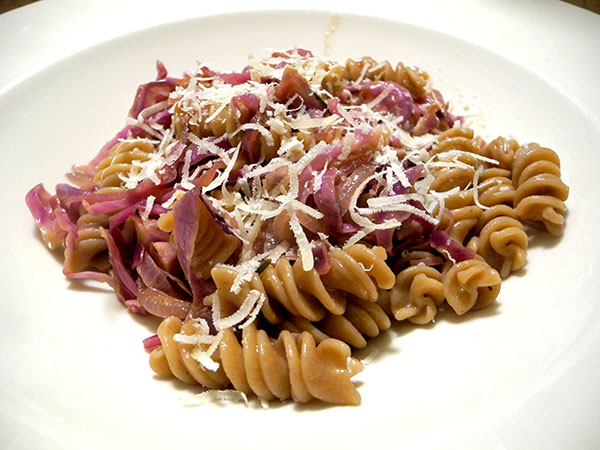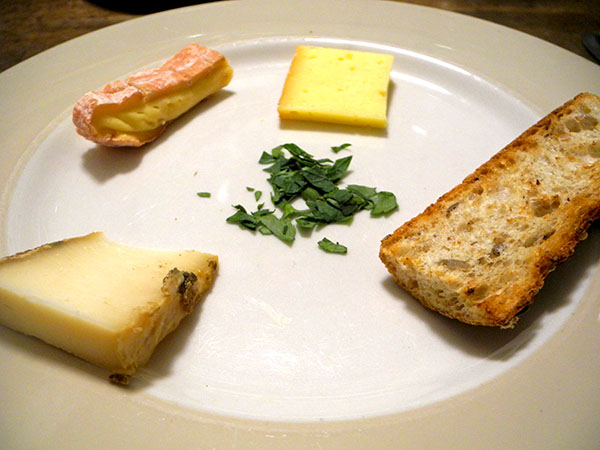
Wintry and earthy, but first a little sun and sea.
Chestnuts and red cabbage, or more precisely, chestnut pasta and red cabbage. But first there was octopus. I’ve served both of these dishes before, but never anywhere near each other. Last night however, looking around for something to lighten a sturdy pasta, at least with some proximity in time, I pulled a thin package of sliced octopus carpaccio out of the refrigerator and went on to wash, try, and tear the bit of arugula I found inside the crisper.

I had first decided it would be a pasta meal, and had almost immediately zeroed in on one of the several earthy Sfoglini varieties sitting in the larder closet. Unusually for me, I had very few vegetables to go with any of them. I did have one very small red cabbage, and while it’s not the first thing that comes to mind when anyone thinks of pasta, one of the Sfoglini available was a chestnut fusilli, and I had combined the 2 ingredients once before.

After a modest serving, we decided we wanted to go on to a third course, knowing the remaining pasta would be just as good reheated on another day, and aware that we had some great cheeses, and some especially attractive bread for toast to accompany them
The meal went this way.
- octopus carpaccio (sliced, pressed octopus), less than 3 ounces altogether, from The Lobster Place, drizzled with a little juice from a tiny lemon grown locally by David of Fantastic Gardens of Long Island, and a little drizzle of a very good olive oil
- delicious arugula from Keith’s Organic Farm, washed, trimmed, dried, dressed with Moaldon salt, freshly-ground pepper and the same lemon and oil poured over the octopus
- an Orwasher’s multigrain, seeded baguette (it may be a new product) purchased that afternoon at Chelsea’s Down to Earth Farmers Market
- eight ounces of Sfoglini chestnut fusilli (organic semolina flour, chestnut flour, water) cooked until al dente in a large pot of salted water, some of the water reserved near the end before it was drained, added to a large enameled cast iron pot in which earlier one thinly-sliced red onion from Stokes Farm had been softened in a couple tablespoons of ‘Kerrygold Pure Irish Butter‘, to be followed by one large minced garlic clove from Stokes Farm, stirred until fragrant, 3 or 4 rosemary branches from Stokes Farm tossed in and heated for a minute or so, more butter added at that point, followed by about half a pound of cored and thinly-sliced red cabbage from Tamarack Hollow Farm, all stirred well then cooked, covered, for about 15 to 20 minutes, or until tender, with a few tablespoons of balsamic vinegar poured in near the end of the cooking, followed by the addition of one chopped heatless Habanada pepper form Norwich Meadows Farm, everything stirred again, the pasta now added to the cabbage, and some of the reserved pasta water introduced into the sauce in stages while the mix was stirred above a low flame to keep it moist, then portions transferred to shallow bowls and served with freshly-grated Parmigiano Reggiano Vacche Rosse from Buon Italia sprinkled on top
- a cheese course of 3 Consider Bardwell Farm selections, ‘Manchester’, a medium-hard goat cheese‘, Experience’, a pasteurized, somewhat soft cow cheese, and ‘Pawlet’, a medium-hard cow cheese, served with toasts made from the same Orwasher’s multigrain, seeded baguette served with the first course
- the wine throughout was an Italian (Toscana) white, Prelius Vermentino Toscana 2015, from Chelsea Wine Vault
- the music was Wagner’s ‘Das Rheingold’, a 1967 performance with Herbert von Karayan, the Berliner Philharmoniker, and an amazing cast: Dietrich Fischer-Dieskau (Wotan), Robert Kerns (Donner), Donald Grobe (Frohe), Gerhard Stolze (Loge), Zoltán Kelemen (Alberich), Erwin Wohlfahrt (Mime), Martti Talvela (Fasolt), Karl Ridderbusch (Fafner), Josephine Veasey (Fricka), Simone Mangelsdorff (Freia), Oralia Dominguez (Erda), Helen Donath (Woglinde), Edda Moser (Wellgunde), Anna Reynolds (Floßhilde)